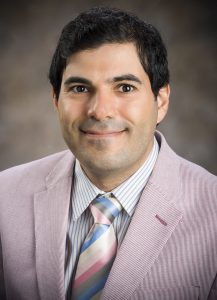The next generation of data scientists can be found in the classroom of Amir Zadeh, who teaches Wright State University business students how to analyze and find meaning in visualized data.
Zadeh, associate professor of management information systems, teaches the data visualization class for students pursuing their master of accountancy degrees. Students work with financial accounting data such as account payable, account receivable, revenue, expenses, cost accounting and general ledger.
“What makes this class so special to me is the hands-on nature, which students absolutely love,” said Zadeh. “Students tell different stories from different perspectives with data visualization. Also, working with graduate students who are eager to learn from scholarly articles and journals and do research is very rewarding.”
Data visualization is the graphic representation of data, producing visual elements that communicate to viewers discoveries and insights hidden in data. The data is visualized using computing resources available at the college’s Data Analytics and Visualization Environment, or DAVE lab.
The 1,000-square-foot lab features a mini supercomputer and visualization software. It is used to teach students business analytics, which is becoming a huge part of how corporations and organizations do their jobs.
Students acquire data from multiple sources, collect it in a single location, select the relevant information and then use software tools to analyze it and find meaningful and useful knowledge.
The large, wall-sized screen in the lab is segmented into 12 sections. It can display 12 different sets of data and images at once or any number of combinations, such as four sets of data on three screens, two sets of data on six screens and so forth. The lab also provides a multi-platform training environment for enterprise systems and big data technologies such as Microsoft Dynamics ERP that enable students to put their classroom knowledge into practice through hands-on experience.
“Not only is Amir preparing these students for the advanced knowledge in business analytics that will be expected of public accountants in the future, he is ensuring they meet the requirements to receive SAS certification in business analytics,” said Thomas Traynor, dean of the Raj Soin College of Business.
SAS is a multinational business analytics software and services provider and its software is used by most Fortune 500 companies. SAS software solutions help access, manage, analyze and report on data to aid in decision-making.
“Amir has built a good relationship with SAS through which he has qualified students in multiple areas of business for SAS certifications while they are taking classes that are a regular part of their respective curricula,” said Traynor. “SAS decided to highlight Amir in a document that is used to encourage more teachers and students to seek SAS certificates.”
Zadeh earned his Ph.D. in management information systems from Oklahoma State University. He also holds degrees in industrial engineering and management systems, with a concentration in socio-economic systems, and applied mathematics, with a concentration in computer science.
Zadeh’s research and teaching interests are in business analytics, artificial intelligence, machine learning, big data applications, decision support systems, knowledge management and enterprise systems. He studies the use of enterprise applications, business intelligence tools and techniques for a variety of business problems in information systems, operations management, health care, social networks, cybersecurity and sports.
He developed an interest in technology at a very early age due to his fascination with mathematics, which led to his interest in computing. He was inspired to become an educator by his high school math and physics teachers.
Zadeh said his high school friends often borrowed his class notes because he simplified things so concepts could be easily understood. Years later, he worked with a book publisher to publish all of his notes as a study guide so other students could benefit from what he learned. He wrote several study guides in calculus, statistics and probability, computer programming and operations research.
While working on his master’s degree, Zadeh began working as a system analyst, where he was involved in large-scale IT-enabled business transformation projects in various business areas. He also worked for a researcher on a computer simulation project in a research institute at Technical University of Dresden.
Zadeh’s advice to students is to be open-minded when it comes to learning about systems and technology.
“Learn as many tools and techniques as you can as you try to become more skilled with systems and technology,” he said. “And master at least one programming language, not to mention understanding business as much as technology.”


 Wright State recognizes Nursing Professor Kim Ringo for advancing international student success
Wright State recognizes Nursing Professor Kim Ringo for advancing international student success  Wright State honors graduating students for distinguished doctoral dissertations
Wright State honors graduating students for distinguished doctoral dissertations  Top 10 Newsroom videos of 2025
Top 10 Newsroom videos of 2025  Museum-quality replica of historic Hawthorn Hill donated to Wright State
Museum-quality replica of historic Hawthorn Hill donated to Wright State  Wright State celebrates more than 1,000 graduates at fall 2025 commencement
Wright State celebrates more than 1,000 graduates at fall 2025 commencement 